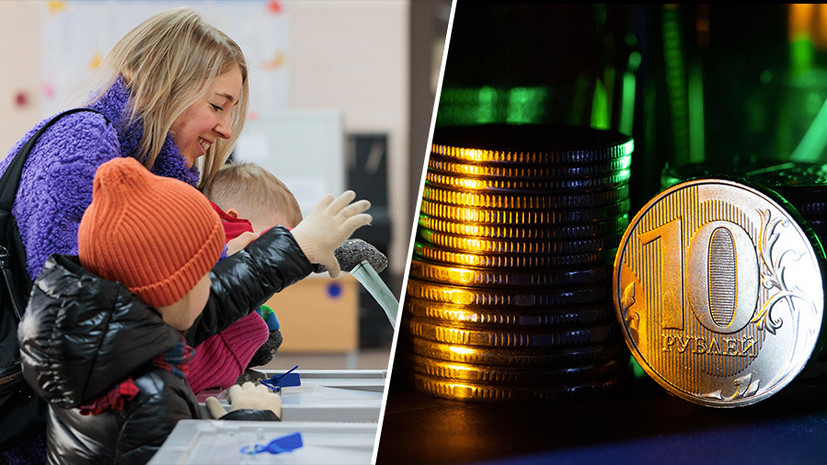On Monday, March 18, foreign currency rates decrease on the Moscow Exchange.
During trading, the value of the dollar fell by 1.15% to 91.83 rubles, the euro by 1.11% to 100.1 rubles, and the yuan by 1.1% to 12.73 rubles.
The Russian currency is steadily rising in price against the American, European and Chinese ones after a noticeable weakening that started on Friday.
Thus, on March 15, the dollar exchange rate on the Moscow Exchange exceeded 93 rubles for the first time since the end of February, and the euro and yuan rates reached 101.25 and 12.88 rubles, respectively—the maximum values since the beginning of 2024.
Moreover, on Monday morning the indicators briefly rose to 93.44, 101.7 and 12.94 rubles, but then began to decline.
“We believe that the weakening of the ruble on Friday was largely psychological in nature.
Market participants preferred to increase their positions in foreign currency to diversify possible risks in the run-up to the elections,” Natalia Pyryeva, an analyst at Digital Broker, suggested in a conversation with RT.
In her opinion, investors were afraid of various geopolitical provocations against the backdrop of the ongoing vote, but ultimately these risks did not materialize, and the situation on the stock exchange stabilized.
A similar point of view is shared by Mikhail Zeltser, an expert on the stock market at BCS World of Investments.
“Last week, provocations at the border became more frequent, which was obviously related to the upcoming elections.
Speculators quickly took advantage of this, and the geopolitical risk premium in the national currency exchange rate expanded.
Nevertheless, the elections themselves took place without incident.
Markets stabilized and the speculative premium quickly collapsed.
Hence the systematic recovery of the ruble,” explained RT’s interlocutor.
RIA News
© Maxim Bogodvid
Let us remind you that the Russian presidential elections took place over three days - from March 15 to 17.
Based on the results of processing 99.94% of the ballots, the current head of state Vladimir Putin received 87.3% of the votes, the second place was taken by the candidate from the Communist Party of the Russian Federation Nikolai Kharitonov (4.32%), the third place was taken by Vladislav Davankov from the New People party (3.83%). ), and fourth - Leonid Slutsky from the Liberal Democratic Party (3.2%).
This data is provided by the Central Election Commission.
“Putin’s victory means that the rules of the game for investors and business will remain more or less clear.
In the near future, many will be waiting for news about the new composition of the Cabinet and announcements about possible adjustments to the economic course, although significant changes are unlikely to happen.
In general, the new certainty regarding the election results is now one of the factors supporting the ruble,” said Sergei Suverov, Associate Professor at the Financial University under the Russian Government, in a conversation with RT.
According to the expert, additional help to the ruble at Monday's auction could have been provided by a record increase in oil prices in four months.
Thus, on March 18, the price of Brent crude on the ICE exchange in London rose by almost 1% and for the first time since November 6 reached $86.27 per barrel.
In addition, the tough monetary policy of the Central Bank has a positive impact on the ruble exchange rate, says Mikhail Zeltser.
Thus, in recent months, the Central Bank has kept the key rate at a high level of 16% per annum and is expected to leave it unchanged at the upcoming meeting on March 22.
While maintaining such a strict monetary policy, loans remain expensive, businesses purchase foreign goods less often and, accordingly, purchase dollars, euros and yuan in smaller volumes.
At the same time, the influx of funds into deposits in rubles is growing due to high deposit rates, which also supports the exchange rate of the national currency.
RIA News
© Sergey Guneev
In addition, according to Zeltser, the mandatory sale of foreign currency earnings by exporters still plays in favor of strengthening the ruble.
By decree of Vladimir Putin, by the end of April, businesses must return at least 80% of dollars, euros and yuan earned from abroad.
Moreover, at least 90% of the transferred funds need to be exchanged for rubles.
The mechanism was launched back in October 2023 to support the national currency, and the government plans to extend its validity until the end of 2024.
“Technically, the multi-month range of the dollar exchange rate of 87.5-93.5 rubles continues to hold, and there are no reasons for an extensive weakening of the Russian currency yet.
All volatility surges are quickly extinguished.
Due to a combination of factors, in the coming weeks it is possible that the rates will drop even lower and we will see 90 rubles per dollar, 98 rubles per euro and 12.5 rubles per yuan,” Zeltser did not rule out.
According to Natalia Pyryeva, until May, the dollar will probably continue to trade in the range of 90-93 rubles.
After this, the dynamics of the indicator will depend on whether the government will extend the mechanism for the mandatory sale of foreign currency earnings.
According to RT's interlocutor, if the authorities abandon this idea, the exchange rate could rise to 95 rubles.

